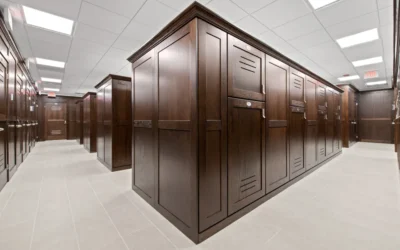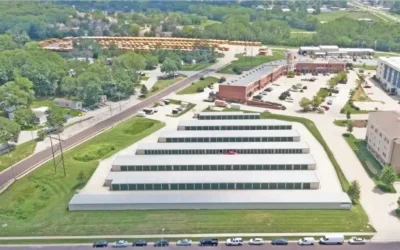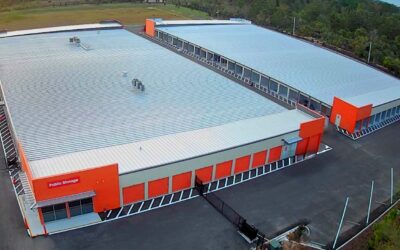Construction spending in the self-storage sector topped $6.9 billion in 2023 as developers moved through a development pipeline that expanded in the wake of the COVID-19 pandemic.
Last year’s spending marked a 24% increase over 2022, which saw $5.6 billion spent building or expanding self-storage facilities, according to U.S. Census Bureau statistics. The sector spent an average $4.4 billion on construction per year from 2019 to 2021.
The pandemic and the associated impact on migration patterns and work from home trends led to a surge of demand for self-storage space in recent years. Average rents and occupancy for storage units soared to record levels, and developers rushed into the space to build new inventory.
However, new research from Yardi Matrix suggests that the sector has reached a turning point. In a new report, the research firm anticipates a reduction in deliveries of newly built self-storage space beginning in 2025. One reason for the change in outlook: a sharp rise in deferred and abandoned self-storage projects across the country
Expand and contract
The industry is undergoing a near-term expansion of supply as the wave of projects initiated in recent years come to completion. The last quarter of 2023 also saw an increase in the number of construction starts and projects starting construction, leading the data analytics firm to raise its projections for the amount of new self-storage space expected to open in 2024 and 2025. Yardi expects the industry to deliver 54.5 million square feet of self-storage space this year, and 47.9 million in 2025.
However, looking further ahead, Yardi cut its long-term projections for self-storage deliveries in 2026 through 2029. The data firm expects annual completions to fall to just over 29 million square feet at the close of the decade.
Abandon ship?
What data points portend this decline in self-storage development activity? The firm noted a marked rise in stalled projects during the second half of the year.
"In the second half of 2023 the number of abandoned and deferred projects in our database has noticeably increased, growth in both the planned and prospective pipelines has stalled and the year-over-year change in street rates was negative in 2023," said the report.
The downward trend in rates may have made some planned projects no longer viable, leading investors to pull the plug. A total of 245 planned storage developments were canceled in 2023.
According to Yardi: “The number of deferred projects grew 44.5 percent on an annual basis and the number of abandoned storage properties increased 104.2 percent compared to 2022.”
A noticeable slowdown
Marc Boorstein, principal of MJ Partners self-storage advisory, said the chill in self-storage development is mostly driven by two interrelated factors: falling move-in rates and a challenging lending environment for commercial real estate.
Boorstein’s firm advises about 30 developers nationwide—representing about half of the total activity in major markets. While typically each would have several projects in the works right now, many are down to a single project, if they have any at all.
“The construction lending environment is so difficult,” Boorstein said, “It is really slowing down new activity.”
The number of storage completions nationwide is projected to fall from between 500 and 600 the past few years, to around 400 this year, and trending lower for next year’s new deliveries. Boorstein said major lenders are skittish on commercial real estate loans in general, with smaller regional lenders picking up some of the slack. But Boorstein said even then, regional lenders are scrutinizing deals more than ever and the interest rates are higher. That’s caused developers to press pause and wait for the market conditions to improve.
The slowdown should be a real positive for existing facilities, who will have less new competition to deal with as they try to grow rates, Boorstein added.
Falling rates
A lack of rental rate growth in the storage sector has made it difficult for new projects to get funded.
“Last spring and summer there wasn’t a big pop in rental activity,” Boorstein said, “The developers and lenders look at the move-in rates and they are lower than they were last year.”
Another factor pulling down storage rents is the steep discounting the REITs are offering at move-in, particularly Extra Space Storage, whose acquisition of 1,200 Life Storage facilities made it the largest operator in the industry. The strategy of offering low introductory rates has proved to be effective when it comes to gleaning market share from private operators. The public operators have been able to raise rates on customers later on in their tenancy, while still retaining high occupancy levels exceeding 90%.
Private operators are following suit, Boorstein noted, with third party management companies slashing rates for properties in lease up to fill them up quickly.
“They are finding a lot of success, some increasing rates much quicker than anticipated, after three or four months instead of six months or a year,” Boorstein said.
Wait and see
But for lenders, it is difficult to underwrite a new development when lease up is at a lower rate, Boorstein added.
Looking at last year’s results, Boorstein said the assumption is that there will be no rent growth during the first half of the year and that it could accelerate in the second half of the year if the residential housing market opens up.
“If all of a sudden the home market picks up really strong, the self-storage development will pick up fast,” Boorstein said.







